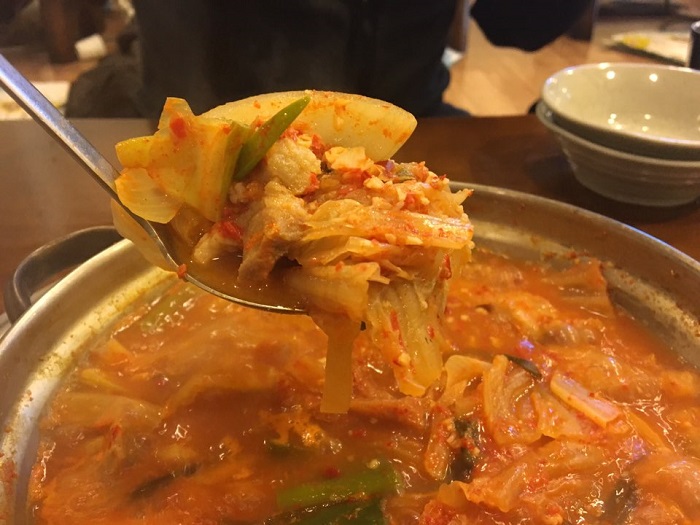Korean cuisine just wouldn’t be the same without its vast and various varieties of kimchi. There are 187 officially-recognized varieties of kimchi listed at the Kimchi Field Museum in southern Seoul. In reality, however, that number is most likely an underestimate, as every family has its own traditions and ingredients, and most people will swear that their own grandmother’s kimchi is the most delicious. To begin just with the vegetables, fermented and peppered cabbage (배추 김치) is probably the most common type of kimchi, but there’s also Asian radish kimchi (깍두기), green onion kimchi (파 김치) and cucumber kimchi (오이 소박이), among the many, many other varieties of fermented vegetable that abound in Korean cooking.

Kimchi soup is one of the most common Korean dishes, available in Korean restaurants around the world.
Not only by ingredient, kimchi also varies by season. Traditionally, the gimjang (김장) period that falls roughly in November is when traditional agricultural communities would come together to pickle and ferment their cabbage and other vegetables for the winter. This guaranteed vitamin C during the months of no fresh vegetables. This preparation, in fact, is also part of the reason why the winter can see the widest variety of kimchis on the table.
The fermenting vegetables were stored in large underground ceramic vats called onggi (옹기), ensuring that they didn’t freeze in the sub-zero temperatures and creating a comfortable environment for fermentation to take place over the winter months. Like casks of preserves, each ceramic vat could be cracked open as the winter progressed. Handling, making and managing the farming families’ communal onggi underground ceramic vats encouraged the farmers to work together as a team, and it formed a sense of community in pre-urban, pre-industrial, agriculture-based Korea.

Pork and tofu are added to the dish to add some protein, creating a balanced meal in one pot.
As the spring slowly began to sprout, families now had access to freshly-picked vegetables for fresh kimchi, leading to styles of kimchi that require less fermentation, or no fermentation at all. Finally in the summer, Asian radishes, spinach, cucumbers and other summer vegetables make it into the family’s diet of kimchi, varying the side dishes beyond mere red fermented cabbage.
As well as the ingredients and the seasons, kimchi also varies by location. Cuisines from the northern Korean provinces and southern Manchuria tend to be less salty and less spicy than cuisine from the southern provinces of the peninsula. The north, closer to the banks of the Amnokgang River (압록강) and the Dumangang River (두만강), has winters that are much colder and harsher. The south, especially along the Nakdonggang River (낙동강), has summers that are much more lush and humid. Northern Korean cuisine also tends to use no brined seafood, whereas brined shrimp or anchovies are common in southern Korean cuisine.
Kimchi itself can be used as an ingredient in a range of dishes. Savory kimchi pancake or fried rice & kimchi are both simple and delicious. However, aside from the side dishes themselves, the most common kimchi dish is probably kimchi soup (김치 찌개). Not only is it a soup — arguably the foundation of the Korean meal — but it’s a kimchi soup, using the iconic fermented vegetable dish as its main ingredient. You get your fiber and vitamins from the vegetables found in the kimchi and you get your protein from the pork and tofu added to the soup. Well-balanced and inexpensive, kimchi soup is a staple across the nation and across Korean restaurants worldwide.

People from all walks of life enjoy a hearty bowl of kimchi soup to keep them warm during the winter months.
There are numerous restaurants around Seoul, Korea and the world that serve kimchi soup. The taste varies, depending on the kitchen, but the main ingredients generally remain the same: cabbage kimchi snipped into bite-sized pieces, pork shoulder cut into bite-sized chunks, red pepper paste or, more commonly, red pepper flakes, or even both, a dash of sugar, water, green onions and a pack of tofu. Some people add rice wine or black pepper, slices of onion, mushrooms, chili peppers or a bit of oil, too.
As you eat your way across Korea, it’s encouraged to try as many dishes of kimchi soup as you can. Each region and town will have its own variety, though, what with urbanization, industrialization, the standardization of ingredients and the ever-increasing homogeneity of the national palate, the traditionally broad varieties of flavors found across the country have lessened somewhat over recent decades. Nonetheless, go out and enjoy a hearty dish of kimchi soup this winter. It will give you a taste of the geography and the seasons of the Korean Peninsula and will keep you warm until spring comes around again.
By Gregory C. Eaves
Korea.net Staff Writer
Photos: Gregory C. Eaves
gceaves@korea.kr























